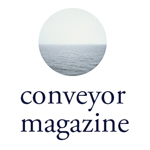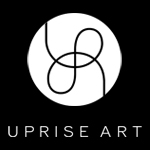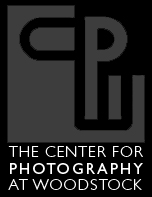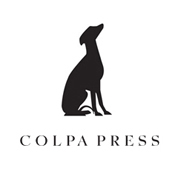Leif Huron’s The Valley at Tribeca Film Festival

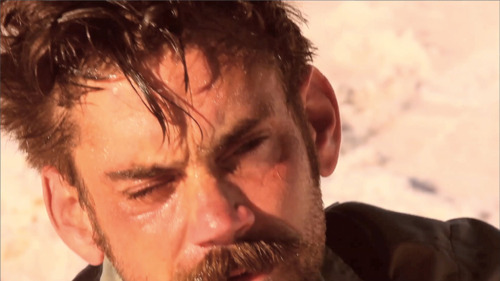
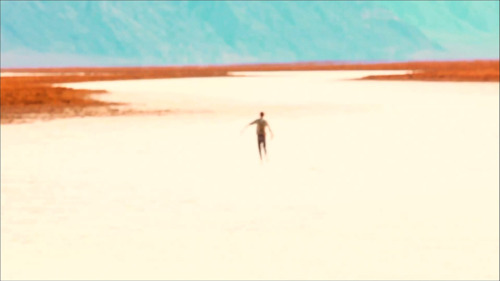
Leif Huron, whose work has graced the pages and walls of several Conveyor Arts productions, is screening his short film The Valley in the Journeys Across Cultural Landscapes program of this year’s Tribeca Film Festival.
Huron’s 10-minute gem examines an instability between wild and domestic space. It plays on the tension between search and enclosure, territory and flight, the desire to aspire, and a need to find home.
The Journeys Across Cultural Landscapes program will be shown on April 19 and 27 at 7pm (Clearview Cinemas Chelsea 5), April 28 at 11:30pm (Clearview Cinemas Chelsea 7), and April 29 (Tribeca Cinemas Theater 1). Q&A with Huron and the other filmmakers in the series will follow.
Clearview Cinemas Chelsea
260 West 23rd Street between 7th & 8th Avenues
Tribeca Cinemas
54 Varick Street at Laight Street
Happenings: The Crystal Chain at INVISIBLE-EXPORTS
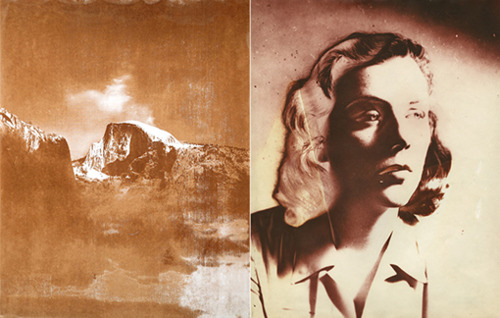
The Crystal Chain, an exhibition curated by Matthew Porter and Hannah Whitaker, will be opening at INVISIBLE-EXPORTS today with a reception from 6 to 8pm. This lovely group exhibition is running in conjunction with Porter’s and Whitaker’s edit of the upcoming issue of Blind Spot, which will be on the stands in May.
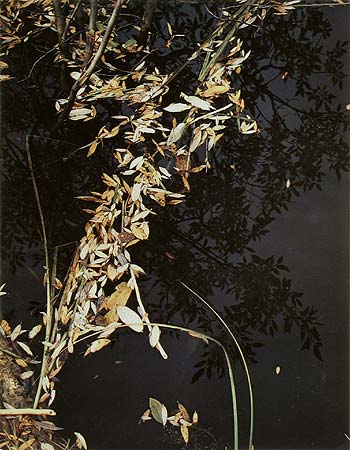

Described by the curators as “summits of accumulation,” the works included in the show are haunting and illusive and yet deeply physical and associative, too. The degrees of separation between the photographs - often subtle and slippery - create a sense of undeniable longing more than a firm grasp of the linkages. Here’s just one example of the wonderfully complex stylistic and personal connections (from the press release): “Breitenbach photographed Bertolt Brecht, who figures in the work of Gerard Byrne, who is friends with Joachim Koester and shares an interest in the restaged trials with Boru O’Brien O’Connell.” This chain of shared histories and interests forms a bond not unlike the fleeting and residual nature of photography itself - moments are solidified and collected from idiosyncratic and evanescent events which nonetheless leave marks on all of us.
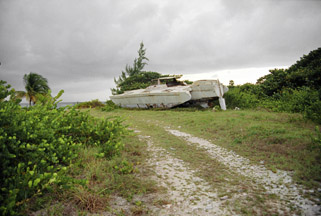
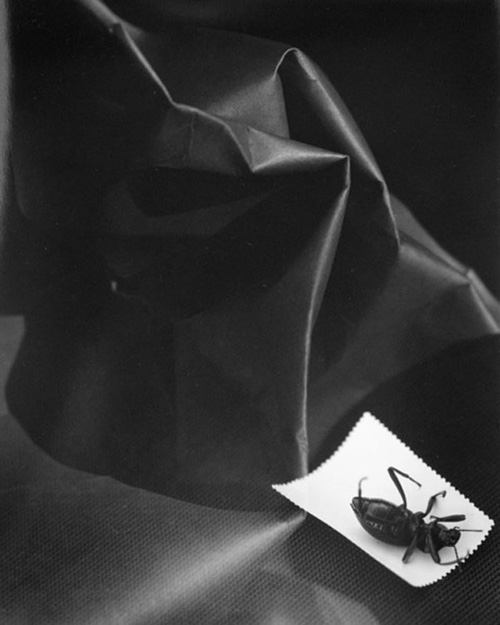
For those who can’t wait for the print version (and who could blame you - it’s an achingly beautiful collection of images), stop by this sneak peak of Blind Spot’s Issue 45 before May 6.
The exhibition and the magazine feature work by Ellen Auerbach, Matthew Brandt, Josef Breitenbach, Gerard Byrne, Phil Chang, Kate Costello, Tacita Dean, Stan Douglas, John Houck, Margarete Jakschik, Joachim Koester, Davida Nemeroff, Boru O’Brien O’Connell, Sigmar Polke, Eliot Porter, Torbjorn Rodland, Shirana Shahbazi, Erin Shirreff, and Annika Von Hausswolff.
“The Crystal Chain”, curated by Matthew Porter and Hannah Whitaker
March 30 – May 6, 2012
INVISIBLE-EXPORTS
14A Orchard Street
(between Hester and Canal Street)
New York NY 10002
Reception: Friday, March 30, 6-8pm
For more information, visit: { http://blindspot.com/lab/lab/the-crystal-chainat-invisible-exports/ }

30 Mar 2012 / 0 notes / happenings Chelsey Morell Blind Spot INVISIBLE-EXPORTS Matthew Porter Hannah Whitaker
Happenings: Victoria Burge at Accola Griefen Gallery
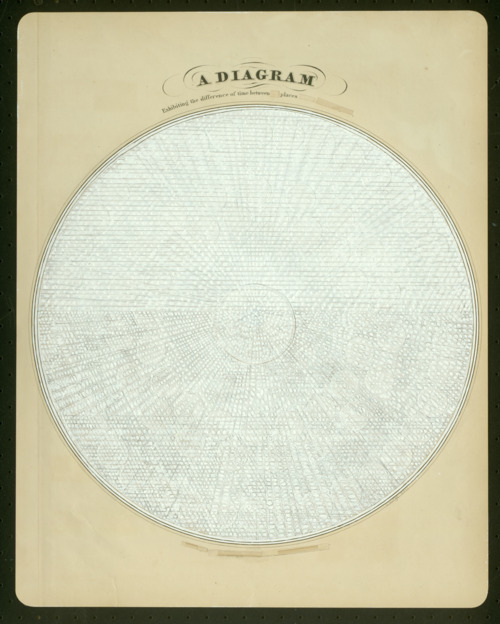
Victoria Burge’s New Work on Paper is currently on view at Accola Griefen Gallery, but only until Saturday, so mark it down on your gallery stops this week! Her pieces beg to be viewed first hand. The installation photographs, and my forthcoming notes, could never give the visual and tactile pleasure it allows in person.
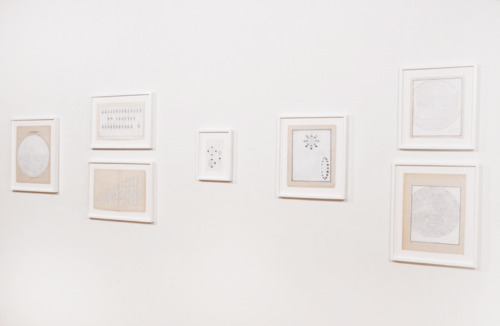

I was delighted to find opportunity to drop into the Accola Griefen Gallery one recent sunny Saturday afternoon. The gallery is located in the back corner of one of the major Chelsea art complexes, a perfect little nook in which to view Victoria’s work in the quiet manner it deserves.
The show includes ten unique prints that seem almost timeless in their execution. The majority of the pieces are acrylic, pencil, ink and other graphic media overlaying ancient maps and astronomy charts, and other novel antique printed matter.
While the first set of prints on antique documents romanticize me, the Pixels on the River series push the notion of traditional print-making into a contemporary realm.
The subtle works are complex in their creation; they are prints that, as I understand it, were created from vector drawings and lazer cut into plexi glass in order to make the impression. The content is inspired by the afterimage that one experiences when looking at the sparkling reflection of sun on water, I couldn’t help but recall this when I was watching the sun rise recently over the the great Lake Superior. Staring at the glittering water, closing and opening my eyes again and again, Burge’s work proved to resonate in a quiet yet lasting way.
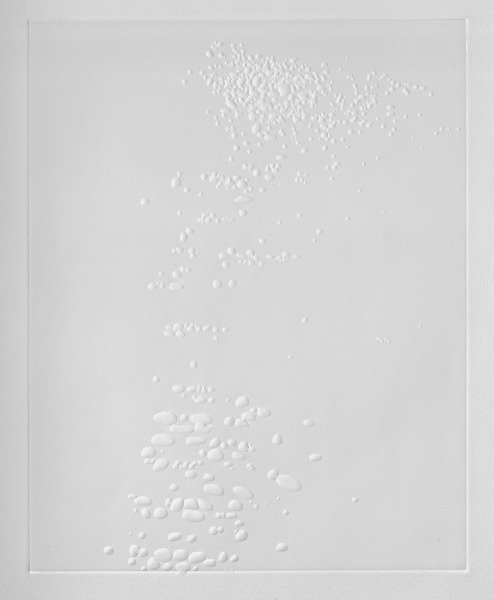
Pixels on the River #3, 2011 { relief printed laser cut }
Victoria Burge was featured on the cover of Conveyor Magazine’s Mapping Issue. Our initial attraction to her work was the unique and intimate approach she mapped and catalogued spaces, be it various cities or the night sky. In the piece featured on the cover, Burge maps by hand, every corner in Manhattan. It also includes the Hudson River, and teeny corner of North Jersey where Conveyor is located!
The cover comes in a special edition CMYK cover.
See some pictures of the issue coming off press below:

You should get your hands on a copy…
Here: { www.conveyorarts.org/mapping }
Victoria Burge
New Works on Paper
On View Through March 31, 2012
Accola Griefen Gallery
547 W 27th Street, # 634
New York, New York 10001
For More Information Visit: { www.accolagriefen.com }
Happenings: Frances Stark at MoMA PS1
Lately, in addition to the still photographic image, we’ve been contemplating the relationship between the moving image and the photograph. And quite soon we’ll be launching a series on the Conveyor blog that investigates work that is tangential yet still related to photography through its visual manifestation, aesthetics, content, thought process, etc. So stay tuned, and for now, enjoy Frances Stark.
My Best Thing, by Frances Stark, is a feature-length animation constructed from a series of conversations and relationships within online video chats.
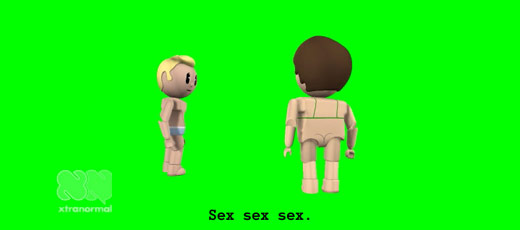
Divided into 10 episodes, the video’s structure takes on the form of a mid-afternoon soap opera that chronicles the conversations of Stark herself, age 44, with two younger Italian men in their mid-twenties. The script is from original conversations with these two characters using an online video chat platform. Using xtranormal.com, an online company that animates text-to-speech, Stark gives their dialogue a voice, albeit a rather monotone and character-less one. The computer-like flat-toned utterances protect the anonymity of the men — the only clue to their identities is computer generated Italian accents. These two avatars engage in sexual play as well as discuss politics, film history, and their personal lives. Ducking in and out, from the purely sexual into the deeply personal. Philosophical moments reach their rise in lines such as “I think that from sexual attraction can be born an idea”, originally written during their discussion of potential collaboration on a project.
While their voices leave no sense of expression of emotion, occasionally a batting of the eyes or a twist of the hips clue us into their feelings. Mispronunciations caused by errors in the software and irregular dynamics in the flow of speech add a layer of humor that points towards the possible absurdity of digitized communication.
My Best Thing made its debut at the 54th Venice Biennale, and is currently on view at MoMA PS1 through the end of March 2012.
MoMA PS 1
22-25 Jackson Ave
Long Island City, NY
For More Information, Visit: { http://momaps1.org/exhibitions/view/342 }
27 Mar 2012 / 0 notes / Alison Chen Frances Stark MoMA My Best Thing PS1 Happenings

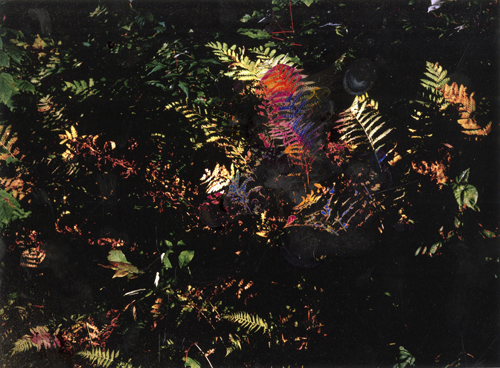
Plants 1, Charlie Rubin, 2012
Parsons The New School for design presents PARTS AND LABOR
Works from the MFA Photography and Related Media Program
In conjunction with Tyler School of Art at Temple University
Though art is always, in the end, integrated into the larger cultural machine, it is difficult to separate a work from its basic procedural origins without the piece losing some of its original character. How and by whom was it made? For what purpose? Intuitive, distinctive, and purposeful acts constitute the artistic discipline, and whether the work reflects a painstakingly articulated surface or a detachment from physicality, there is no escaping their concrete realities.
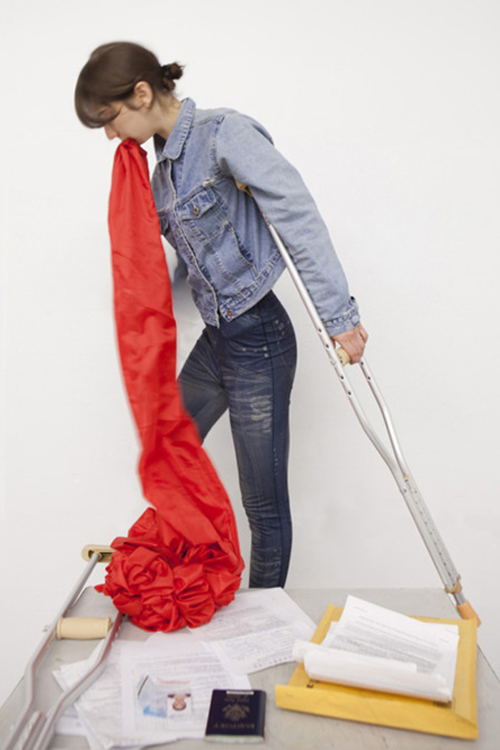
New Passport, Haley Bueschlen, 2011
Even thoroughly conceptual projects go through periods of late-night sketching and have moveable pieces, both real and theoretical, and can trade on references to the process through which they are conceived. Haley Bueschlen, artist and MFA Student at Parsons, uses process and the heavily real objects attributed to the application process in New Passport. In this self portrait she violently asks, “What is my home and do I want to return? How can I return?”. As a resident of both China and the US she says she doesn’t feel American even though she has an American passport and she is not Chinese event though she has spent most of her life there. There is a sense of Lacan’s idea of “Otherness” on a more universal scale in a globalized world that surfaces in her work.

Stills from The Valley, Leif Huron, 2011
An MFA program is a place where process becomes readily apparent and highly deconstructed. As a part in all this labor, I am looking forward to exchanging ideas with Tyler School of Art and the larger Philadelphia communities. If you are in the area, we would love for you to join us for the opening reception!
Opening Reception is this Friday, February 10, 2012, 6:00-8:00pm.
Exhibition Dates: February 10-18, 2012
Atrium Gallery
Tyler School of Art, Temple University
2001 N 13th Street, Philadelphia, PA
Entrance on Norris between 12th and 13th Street
Featuring works by Adam Abel, Alison Chen, Angela Maria Pulido, Charlie Rubin, Chelsey Morell, Christina Labey, Colleen Fitzgerald, Denise Monczewski, Devon Dill, Dominica Paige, Dylan Entelis, Eugen Litwinow, Haley Bueschlen, Jeanette Spicer, John Deamond, Jose Soto, Joy McKinney, Kate Stone, Kreerath Sunittramat, Leif Huron, Light Park, Lisa Haefner, Madelaine Edmonds, Maria Sprowls, Nathan Bett, Noelle Theard, Phoenix Lindsay-Hall, Regis Trigano, Sara Maria Salamone, Sharon Ma, Sylvia Hardy, Terrance James, Tony Flanagan, Yichen Zhou.
10 Feb 2012 / 4 notes / Parsons Sylvia Hardy Parts and Labor Happenings
You Have Been There – departures, bifurcations
You Have Been There – departures, bifurcations, a group exhibition curated by Marie Muracciole at Marian Goodman Gallery, is currently on display, or at least, one of its versions is. This exhibition began in Paris and now that it has migrated to New York City, new artists are participating in the conversation.
You Have Been There assembles a wonderful selection of pieces that work around the idea of departure. Each piece intends to show, in its own particular way, the energy and loss generated by the mutations of trajectories, distances that have either been covered or only imagined, and the processes of displacement.
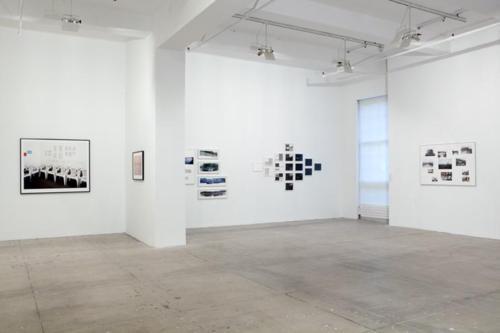
Fourteen artists with very different artistic practices have been gathered in order to make a portrait of departures and bifurcations. They have witnessed separation and have decided to make this separation the starting point of their pieces, giving the concept new dimensions.
Zoe Leonard’s Observation Point/Observation Point is composed of two vintage postcards, hanging at the artist’s eye level, depicting a personalized horizon of her own. The piece speaks to the tourist’s point of view as they look on the American landscape.
Claude Closky’s delightful series, Inside a Triangle, uses the photographic medium as a reference point to look at the world. Similarly inscribed frames depict the leading formal feature that conveys a road or path: the vanishing point at the top of a vertical triangle where the eye stops. The series is displayed as a book of Leporello pages that unfold along the wall, allowing the viewer to walk a path to go through them.
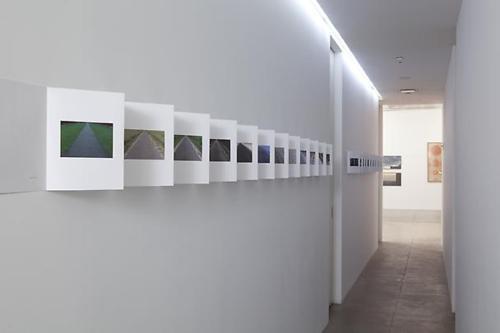
David Goldblatt’s series of three photographs, While in Traffic or The Waiting Room, speak of the banality of the everyday by showing cars jammed in traffic or a waiting room in a credit company. Goldblatt is interested in shift spaces, places where certain states of mind and situations of our mundane life are temporarily held.
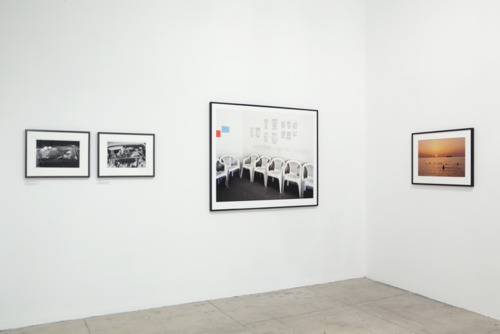
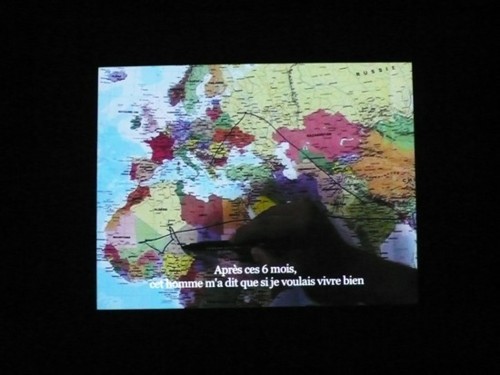
A video projection by Bouchra Khalili, The Mapping Journey Project, tells the story of eight clandestine migrants who tell their story about their voyage to Europe, tracing their journey on a map posted on the wall. The projection is accompanied by three silkscreen prints that transform each journey into a celestial constellation, in which stars become earthly places.
The last video projection located on the 3rd floor is Prey by Steve McQueen, a poetic video starring a white balloon and an old tape recorder, which broadcasts enigmatic sounds. The journey of the balloon disappearing into the blue sky is a futile yet lyrical gesture. The soundtrack of a goodbye.
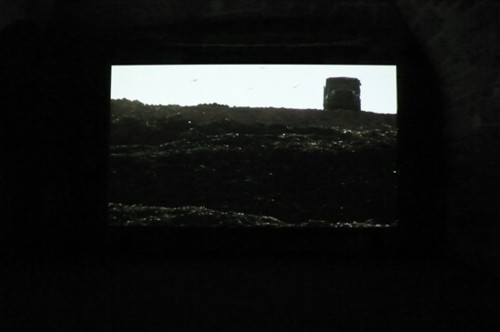
Other artists featured in this exhibition are Moyra Davey, Christodoulos Panayiotou, Dan Graham, Chantal Akerman, Yto Barrada, Jeff Wall, Christoph Keller, and Gerard Byrne.
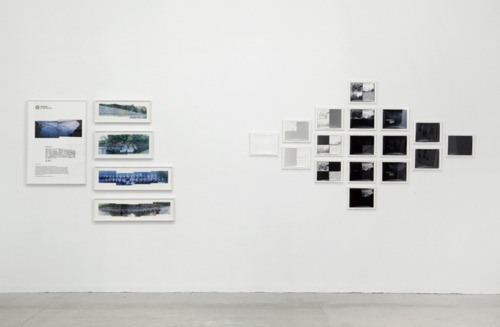
On View Through January 21st, 2012
Marian Goodman Gallery
24 West 57th Street
New York, NY 10019
10 Jan 2012 / 4 notes / Maria Sprowls Marian Goodman Gallery Exhibitions Happenings You Have Been There – departures bifurcations Bibliofile Friday
MoMA’s ‘New Photography’ Exhibition 2011
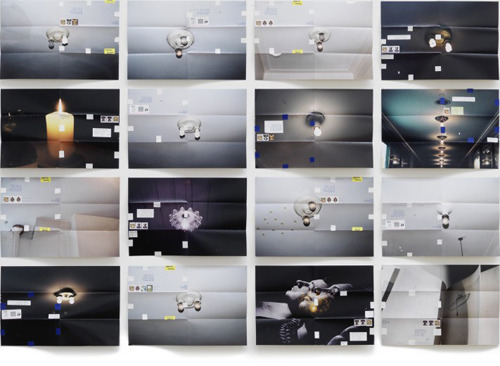
Rester Calme. 2010. Moyra Davey
MoMA’s annual New Photography 2011: Moyra Davey, George Georgiou, Deana Lawson, Doug Rickard, Viviane Sassen, and Zhang Dali, features Dan Leer’s selects for important contemporary photographic artists. MoMA describes New Photography as “capturing the diversity and international scope of contemporary photographic works.” The backgrounds of the artists, as well as their thought process and subject matter, are particularly diverse this year, threading the expanding narrative life of photographs.
Moyra Davey’s work might be the most clever. She posts prints made in MoMA’s archives to friends and then requests them to be re-posted back to her as exhibition pieces. Deana Lawson explores intimacy and voyeurism in visceral portraits of her neighbors in Manhattan, or as she calls them, her “family.” Vivian Sassen’s sensual visual description of parasomnia, an umbrella term for undesired experiences related to sleep, feels emotional and is also a graphic response to her visiting her childhood hometown in Kenya. Doug Rickard carries the meta-appropriation torch, displaying google map images of dangerous locations across America.
However varied and unique each artist’s practice is, the show proves to be quite visually harmonious. A similar color palate is used throughout several of the works, and the selection of images is quite complementary as a group show.
Vivian Sassen’s images are undeniably striking as a singular voice. Sassen’s use of color and simple composition sends viewers into her own journey through parasomnia. She relates to the sleep disorder to her asylum from Africa for a decade.
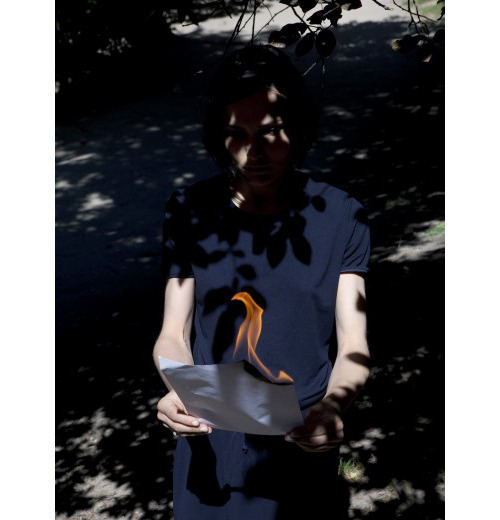
Vivian Sassen. Testament, 2011.
Vivian Sassen. Belladonna, 2010.
Doug Rickard’s, New American Landscape, is a biting critique on the accessibility of our world through the world wide web, commenting on the accidental beauty of images created by Google’s staff documenterians.
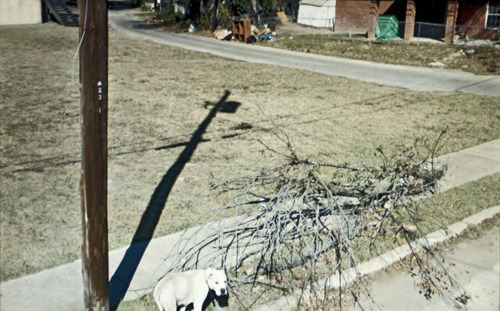
Doug Rickard. #32.700542, Dallas, TX. 2009 2010.
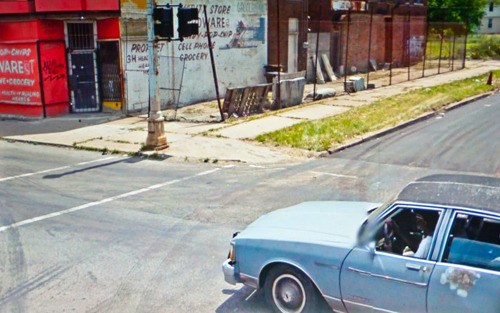
Doug Rickard. #83.016417, Detroit, MI. 2009. 2010.
Deana Lawson is especially appealing to New York enthusiasts, capturing locals that viewers have possibly walked by, seen on the subway or at one of a million bodegas. In their private world, all walls come down. Lawson has a gift for reaching through her lens and grabbing the true character of the subject in front of her.
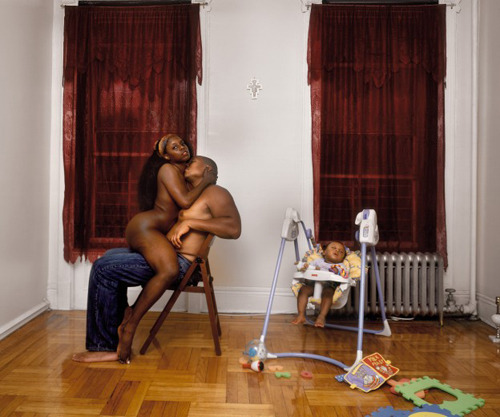
Deana Lawson. Baby Sleep, 2009.
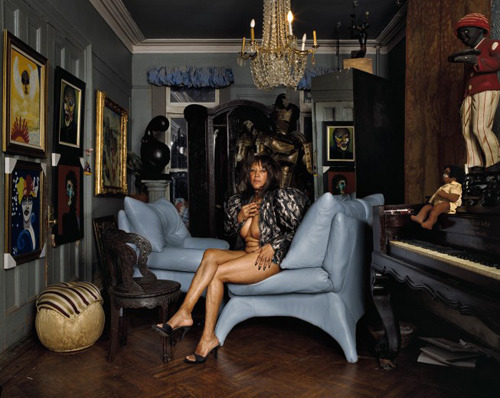
Deana Lawson Diva at 73 Years Old. 2009.
__
New Photography is on view at MoMA through January 16, 2012
For more information visit: { www.moma.org }
5 Jan 2012 / 0 notes / elizabeth bick exhibitions Happenings
Prospect.2 in New Orleans
Founded by curator Dan Cameron, Prospect New Orleans is one of the leading biennials of international contemporary art in the United States. Conceived in the tradition of the great international biennials, such as the Venice Biennale and the Bienal de São Paulo, Prospect New Orleans showcases new artistic practices from around the world in settings that are both historic and culturally exceptional, and contributes to the cultural economy of New Orleans and the Louisiana Gulf region by spurring cultural tourism and bringing international attention to the area’s vibrant visual arts community.
Editor Elizabeth Bick took a trip down to New Orleans to check it out…

Dawn Dedeaux, Video Still, Goddess of Fortunata In An Effort to Make Sense of It All, 2011
Several exciting platforms for creative exhibition and experimentation have been sprouting alongside the re-growth of New Orleans. This past week, I took a trip to check out Prospect.2, the second installation of the New Orleans biennial. This year, twenty-eight international artists exhibit throughout several venues, including the Old U.S. Mint Museum, Contemporary Arts Center, and various public courtyards and alternative spaces throughout the entire city.
The prestigious roster includes a selection of photographs from William Eggleston’s black and white series, Untitled (From the Seventies: Volume Two), and An-My Le’s color photographs of her mother country, Vietnam.
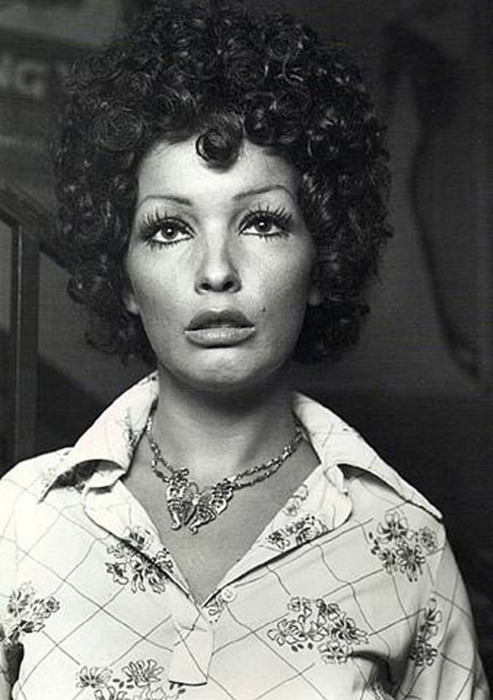
William Eggleston, Untitled (From the Seventies: Volume Two)
The highlights of the event were the installation works of New Orleans native Dawn Dedeaux and Icelandic artist Ragnar Kjartansson.
Goddess of Fortunata In An Effort to Make Sense of It All by Dawn Dedeaux is installed in the historic Brulatour Courtyard in the heart of the French Quarter. Dedeaux creates a visual funhouse, referencing John Kenney Toole’s “The Confederacy of Dunces.” Representations of the Goddess of Fortunata ovetake every corner of the courtyard. Visitors can only enter after dusk, an intriguing requirement. In one corner of the indoor space, a video of dancers in costume feels photographic, a piece that is as impossible to resist as it is difficult to leave.
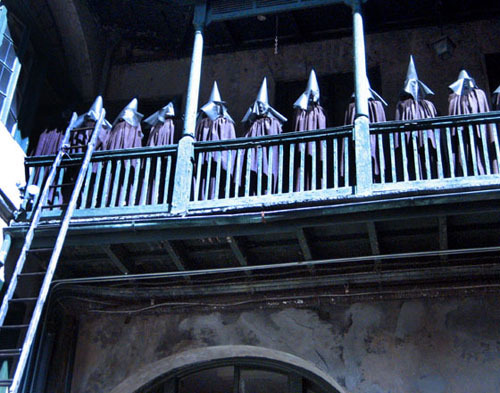
Dawn Dedeaux, Goddess of Fortunata In An Effort to Make Sense of It All, 2011
Ragnar Kjartansson’s video piece, “The Man,” at Old U.S. Mint is much subtler than Dedeux’s visual erruption, however no less striking. Kjartansson, a recent 2009 Venice Bienniale exhibitor, captures a video portrait of legendary Mississippi blues singer Pinetop Perkins. The southern landscape serves as a backdrop, as viewers watch what seems like a private concert. Below is a little taste of this longer video piece.
Ragnar Kjartansson - The Man Sample from Luhring Augustine on Vimeo.
Although Prospect has also undergone several internal shifts and transformations due funding strains and director Dan Cameron’s recent retirement, it is clear through these innovative works that the Crescent City has been not only rejuvenated, but outdone itself.
Exhibition Dates: October 23, 2011 – January 29, 2012
For more information please visit: http://www.prospectneworleans.org
19 Dec 2011 / 0 notes / New Orleans Happenings Elizabeth Bick
Uta Barth Exhibition at Tanya Bonakdar Gallery
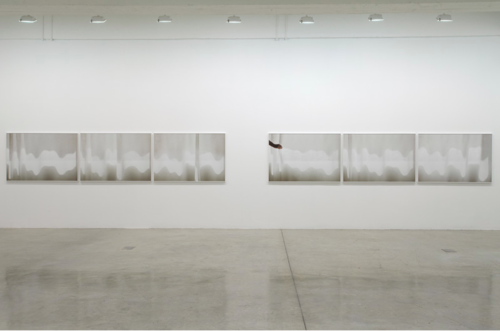
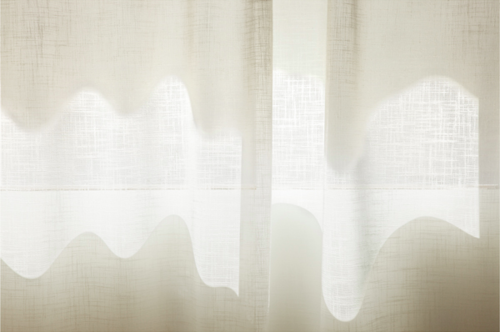
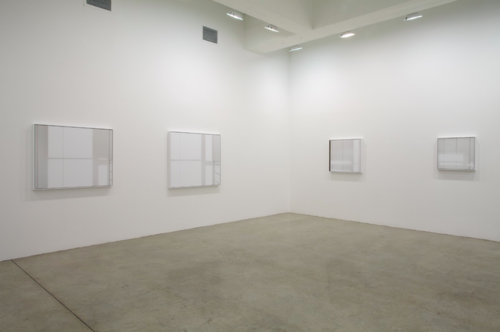

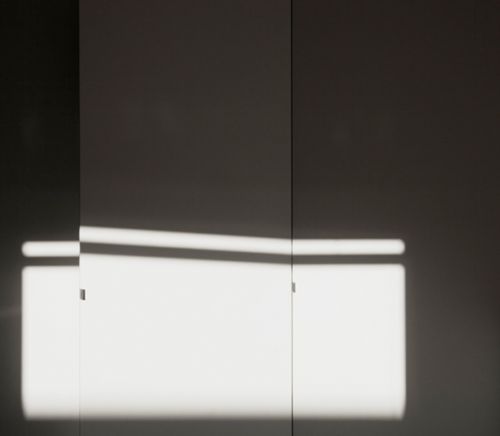
Uta Barth is currently exhibiting her latest body of work, … and to draw a bright white line with light, a series of subtle images created over the course of an afternoon. The photographs seem to whisper a simple request, “Please slowly and quietly walk through my curtain. Feel the sun changing this beautiful scene.” Barth’s work once again invites us to meditate on the intimacy of the autobiographical nature of time in her work. Visual perception is at the forefront of her creative process and has been for quite some time. Dusseldorf photographers notoriously contend that a photograph embodies the emotionless documentation of life. Yet Barth’s out of focus and dreamy images do not describe an objective onlooker. They tell a secret about Barth as an artist.
The simple act of watching light dance across curtains feels monumental in this space. A journey through the installation requires us to step into her eyes and see the clarity of her vision inside everyday life. Against all the complications of our existence, Barth shares a moment of simple admiration.
On view through December 22nd, 2011 at Tanya Bonakdar Gallery
521 West 21st Street
New York, NY 10011
29 Nov 2011 / 5 notes / Elizabeth Bick Uta Barth Tanya Bonakder Gallery Happenings
Film Screening at 25CPW
In collaboration with the launch of Red Roots Gallery and the Macabre & Mysticism exhibition, Conveyor will be screening a handful of films in the 25CPW Gallery this Saturday Night Only!

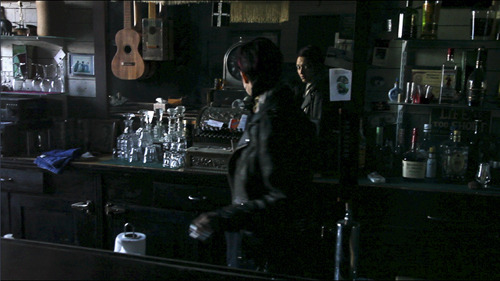
AND, OF THE OTHER, a film by Leif Huron
My parameters are simple… To place one subject on liminal terrain in which the demarcation between wild and domesticated space is not entirely fixed. This film is my provisional framing of an observation of this phenomenon moving through time.
My interest is to explore a narrative strategy that values condition over plotting; to initiate a zone of indeterminacy, images not entirely crystallized, a potentiality of outcomes and sensory [inter] relations not resolved, but strange, mutable and alive.
Saturday will mark the first screening of AND, OF THE OTHER in it’s final state!
AND, OF THE OTHER
Video Projection
Camera+Scenario+Edit: Leif Huron
Main Theme: Jason Millard
Sound Design: toiletooth
-

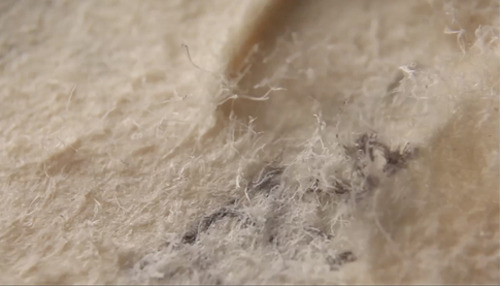
aphasiaticisms (x study) by Jeremy Haik
Recently I have been dissecting the physical form of language in the printed word. Using various material and digital means, I remove and alter textual forms from the covers and pages of books. The resulting works take the form of either still or moving images. This process involves a conscious effort to remove the fundamental purpose of textual signs which is to explicitly name the text, author, and ideas contained within. Yet when this fundamental element is removed or obscured there still remains the matter of the book itself. The colors, shapes, images etc. that surround the place where the text resides are not invisible and carry a significant phenomenological and conceptual weight. The work is a move towards understanding exactly where those visual elements are situated within my field of vision as it moves between the physical forms of the book, and as my frame of mind moves between the ideas the text contains. Among my concerns within the work are questions of authorship, archival impulses, the metaphysics of presence, and the misplaced desire for immediate access to absolute meaning.
Jeremy Haik is an artist and film-maker living in Brooklyn. He is currently pursuing Masters of Fine Art in Photography, Video and Related Media at the School of Visual Arts. His work looks at the slippages and inconsistencies of language through the combination of material and digital practices. His website is { www.haikstudio.com }
-
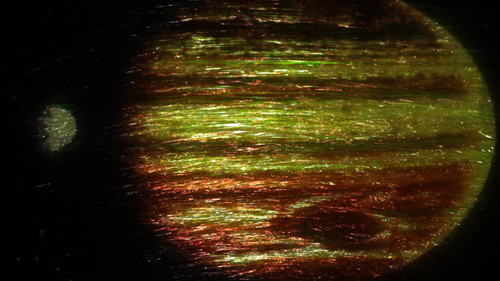

Systems, a film by Molly Surno & Colin Sonner
Molly Surno is artist and curator based in Harlem. Currently she is enrolled in the Visual Arts MFA program at Columbia. She has exhibited her multimedia installations in galleries throughout the country, and is represented by Gasser Grunert Gallery in Chelsea. Three years ago she founded an avant garde film and live music performance series Cinema 16, which has showcased spaces such as the Metropolitan Museum of Art, PS1, and the Kitchen. Her work has been featured in the New Yorker, New York Times, LA Times, Wall Street Journal, NYLON, Filmmaker Magazine, Vice, among others. { www.mollysurno.com }
Colin Sonner is a Brooklyn based director and cinematographer. He has directed short films and music videos and shot for, inter alia, the BBC, PBS, and A&E. He also holds an MA in Philosophy from Boston University.
—
Macabre & Mysticism
Exhibition Opening
Saturday, October 29th from 6 – 10pm.
Red Roots Gallery
25 Central Park West
New York, NY 10023
For more information visit: { www.redrootsgallery.com }
28 Oct 2011 / 11 notes / Happenings Leif Huron Molly Surno Colin Sonner Jeremy Haik 25CPW Red Roots Gallery
Macabre & Mysticism at Red Roots Gallery
Motifs of macabre and mysticism have been visible in art since it’s inception. The curiosity of both the tragic and the transcendent dates back to pre-historic cultures, and remain a common theme in contemporary art.
In many early cultures artisans communicated with otherworldly beings though funerary statues carved for loved ones who were making their way from the earthly world to the afterlife. Later the Danse Macabre, an allegory of death, surfaced as an artistic genre throughout Medieval Europe. The Memento mori and vanitas traditions of painting, which reminds us that our earthly life is fleeting, flourished in the Renaissance and Golden Age of Dutch painting, and remain a popular genre that many contemporary works continue to reference.

Nicholas Alan Cope
Since the advent of the photography, people have been compelled to capture on film what is unseen by the naked eye; from the crime scenes of Weegee or the Disaster Series of Warhol, to the ever-popular genre of spirit photography, we are compelled to document that which questions and transcends our earthly existence.
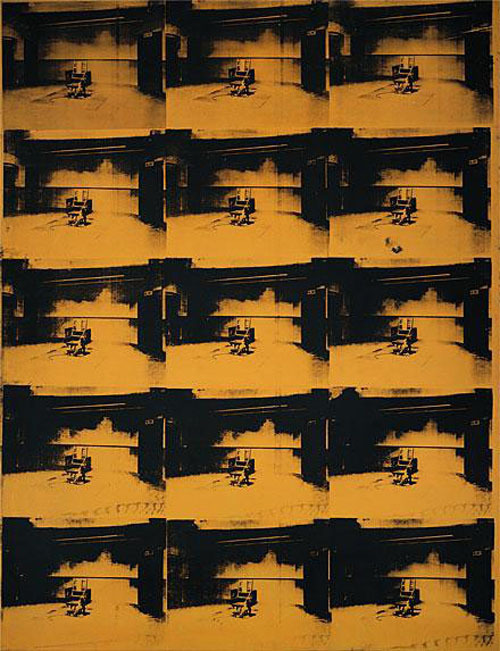
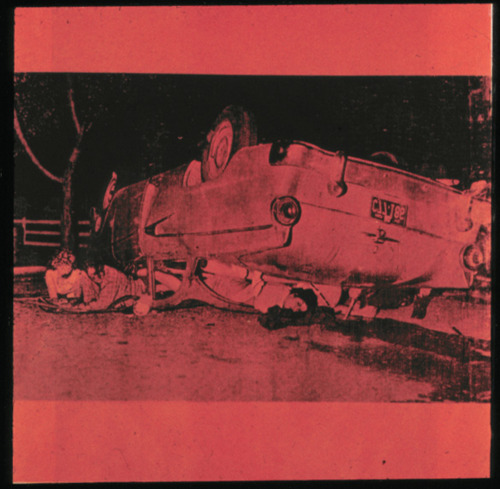
Andy Warhol
Through dioramas of true crime scenes and the invisible nuances of historically haunted houses, our guest curator Corinne May Botz captures this hint of the supernatural in her photographic series “The Nutshell Studies of Unexplained Death” and “Haunted Houses.”
When curating the Macabre & Mysticiscm exhibition, Botz encountered a delicate balance between a sense of dread and a feeling of wonder in the submitted work. She identified historical motifs and used them to weave the show together. The exhibition is rooted in dark narratives that lie just beneath the surface of everyday life, evoking dark romanticism, summoning foreign bodies and creating a displaced experience.

Corinne May Botz
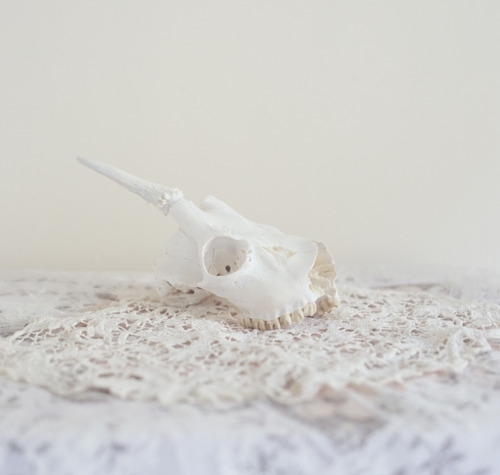
Laura Bell
Corinne May Botz on Curating Macabre & Mysticism at Red Roots Gallery:
“Through carefully composed still-lives that recall vanitas paintings, Laura Bell and Eran Gilat create and represent the vanity of life and encroachment of death through symbolic objects. In Caitlin Parkers film Regression, we see an uncanny splitting of the conscious and unconscious self as a hypnotist guides us into fragmented slippages of time and place.
Phoenix Lindsey-Hall’s reflections of LGBT hate crimes throughout America explore notions of self and other. Her installations reveal the transgressive nature of everyday objects and put the viewer in the uncomfortable position of determining who is the perpetrator and who is the victim.
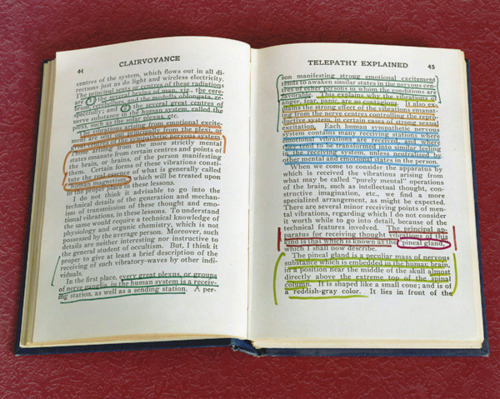
Darin Mickey
Emile Askey’s subtle diptychs target the subliminal stimuli of the viewer to summon both confusion and fear. Brea Souder’s surrealistic photographs icily dissect and recreate the dreams journals of well-known scientists and philosophers, while Darin Mickey’s photographs of everyday objects retain a matter of fact existence infused with a sense of mysticism.”

Brea Souders.
Macabre & Mysticism opens this Saturday, October 29th from 6 - 10pm at Red Roots Gallery and will remain on view until December 16th, 2011.
Red Roots Gallery
25 Central Park West
New York, NY 10023
For more information visit: { www.redrootsgallery.com }
Sasha Bezzubov & Jessica Sucher in Conversation
Conveyor magazine editor-at-large, Elizabeth Bick, spoke with Sasha Bezzubov about his collaboration with Jessica Sucher for their show currently on display at Daniel Cooney Fine Art, Facts on the Ground. Sasha and Jessica will be giving an artist talk at the gallery this Saturday, October 15th at 3pm!
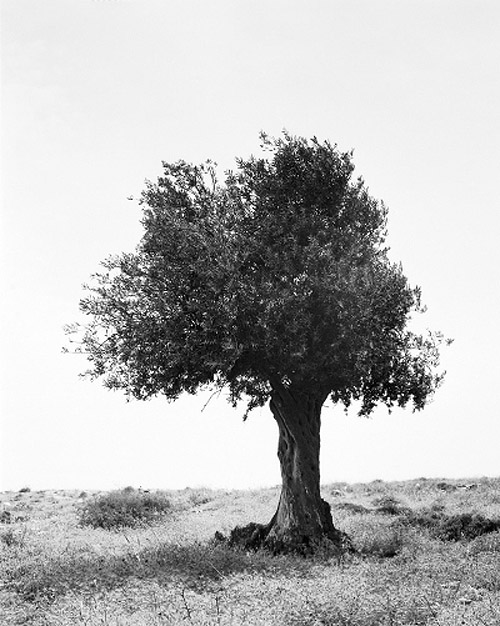
With their series of landscape photographs, Facts on the Ground, Sasha Bezzubov and Jessica Sucher respond to the familiar yet affecting press photos, which depict the suffering and violence of the Israeli-Palestinian conflict. Bezzubov and Sucher approach the conflict in a nuanced and descriptive way, creating images that permit the contested terrain to speak for itself. Their work represents the land as a retainer of history. The two artists photographed the remains of Palestinian villages that Israeli forces destroyed in the wars of 1948 and 1967. They also photographed the occupied territories, where Israeli settlers and the Israeli army continue to dispossess Palestinians of their land and Palestinian farmers of their the olive trees.

Bezzubov and Sucher used a large format camera and created large-scale prints in an attempt to depict these scenes in a way that mainstream journalism cannot. The power and scale of landscape photography allow a seemingly simple image to offer the viewer multiple modes of interaction. As the viewer transitions from one mode to the next, subterranean meanings unravel over time.
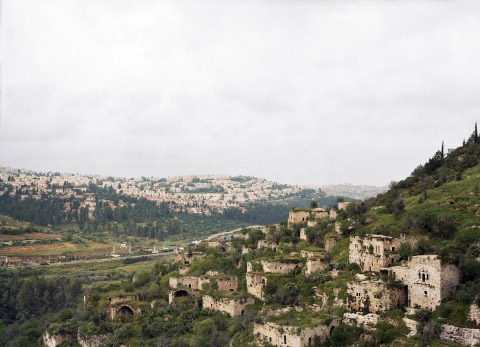
CM: The upcoming issue of Conveyor Magazine is on the theme of Mapping. Obviously, this particular project deals with several forms of mapping, territory, borders, possession. Can you talk more about the significance of mapping with respect to the land you represent in your series?
SB: The term, “Facts on the Ground” refers to the political idea that the creation of physical realities (i.e. the building of Israeli settlements in the Occupied West Bank)—though illegal according to international law—will become impossible to undo and will result in the continual annexation of Palestinian land. So mapping, territory, borders, history and possession are an integral part of this project and the conflict. The creation of the state of Israel, which accompanied the violent destruction of some 500 Palestinian villages, towns and cities, and the forced removal of some 750,000 Palestinians, was accompanied by a massive re-mapping and re-naming project. According to the new rulers, Palestine had to be “Judaized,” the names of every geographical feature had to be changed in order to comply with the often manufactured biblical past. A truly Orwellian committee (The Government Naming Committee) gave the newly found state an ancient pedigree. Many wars later, the map of the region continues to be redrawn.
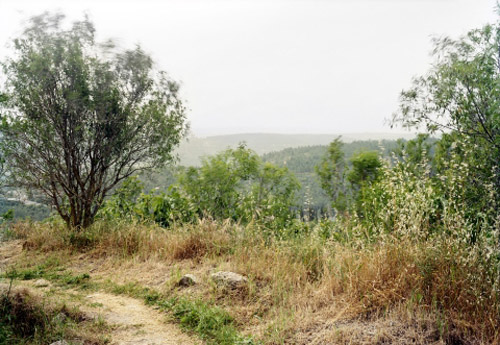
CM: What interests you about photography and mapping? Do you see them as related?
SB: There is a saying, “a map is not the territory.” Similarly it could be said, “a photograph is not the reality.” While they each describe the world in their own manner, through a combination of ubiquity, scientific aura, and social agreement, their role as reliable scientific documents is rarely questioned. But maps and photographs organize the world based on the makers’ vision, politics, tendencies, and loyalties. Both projects can exploit or reveal this aspect of their construction, or perhaps in our case, a bit of both.
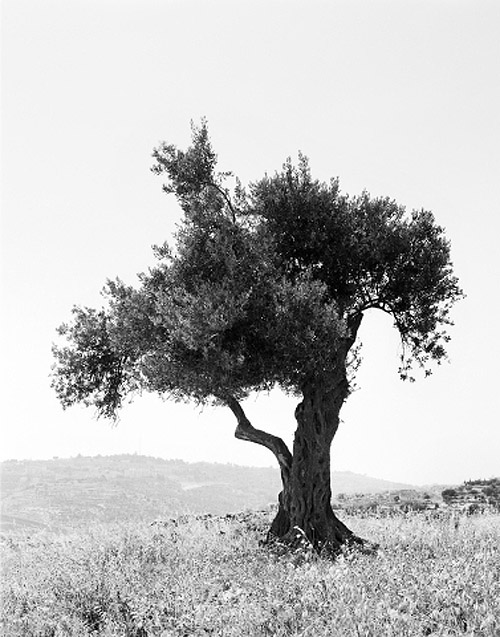
CM: How long have you been collaborating with Sucher? Can you describe some of your other projects?
SB: We began working together on photographic projects in 2002, soon after we became a couple. We have since been married and now have a beautiful three-year-old son. Facts the Ground is our third project as a collaborative team. We have previously worked on The Searchers, a series of four interrelated projects about Western spiritual tourism in India, during a year we spent in India on a Fulbright Scholarship. Our first project is called Expats and Natives. It’s a series of portraits of westerners and their local families in different parts of the developing world. The amount of thought, discourse and argument that goes into every step of our process is something that I have never experienced before.
CM: Now that Facts on the Ground is finished and on display, what effect do you hope it will have?
SB: We are really interested in creating a conversation with this work. We have few illusions that our exhibition and project will affect change in either Israeli policies or the unquestioning support of the United States for these policies. But we do hope that the work will continue to bring attention to this topic and inspire others to continue revealing the great injustice of the Israeli occupation. The Israeli journalist Gideon Levy, whose writing tirelessly describes the many horrors of the occupation, recently answered a similar question with something to this effect, “I write in order that no one will be able to say, “we did not know.”
FACTS ON THE GROUND will be on view September 8 to October 22th, 2011.
Daniel Cooney Fine Art
511 West 25th Street, #506
New York, NY 10001
www.danielcooneyfineart.com
13 Oct 2011 / 0 notes / Elizabeth Bick Jessica Sucher Sasha Bezzubov Happenings Daniel Cooney Fine Art
The Map After Nature
Happenings: La Carte d’après Nature, curated by Thomas Demand
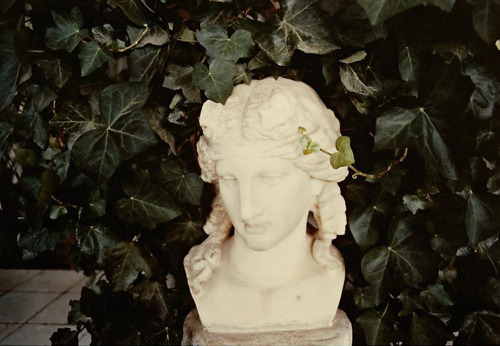
Luigi Ghirri, Capri, 1981.

August Kotzsch, Fliederblüthen (Lilac Blossoms), 1870, Albumen Print.
Is photography inherently indexical? Are images ever a representation of reality? Or are they just a construct of human limitations in relation to their surroundings? These are the questions one may ask while wandering through the eclectic and somewhat cacophonous maze of installed video, sculpture, vintage photographs and sound installation curated by the notorious Thomas Demand.
The title La Carte d’apres Nature reveals Demand’s engagement with the limitations of photography as a form of indexical mapping and whether photographs can be evidence of a certain place in a specific time.
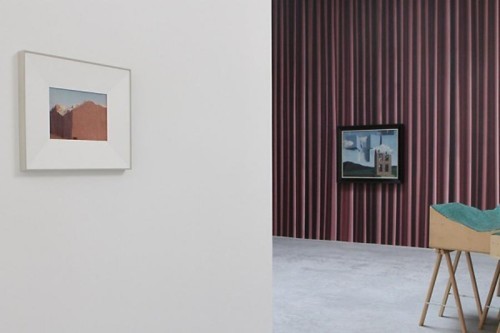
The pictures included by photographers Luigi Ghirri, August Kotzch, Leon Gimpel and others point to the archival and indexical nature of photography, forming a sort of documentary with a vernacular aesthetic. However, the juxtaposition of the photographs with Saadane Afif’s “Strategy of Anxiety,” a sculptural topography, or the green octagonal windows that display vignettes of other installed works, reveals the myopia inherent in the attempt to use photography as an objective document of space and time.
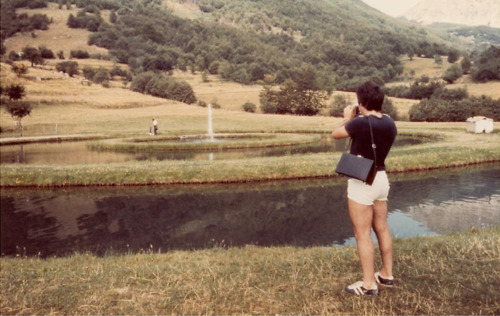
Luigi Ghirri, Rifugio Zamboni, Reggio Emilio, 1972.

Luigi Ghirri, Alpe di Suisi, 1979.
By invoking contemporary concerns, such as the fragility of the planet and the future of humankind (not to mention the rumor of an apocalypse, which, according to the Mayan calendar, is set to approach us next year), Demand may just be indulging in his own version of life after humankind, a futuristic fantasy in which maps will be obliterated along with the human consciousness. — Elizabeth Bick
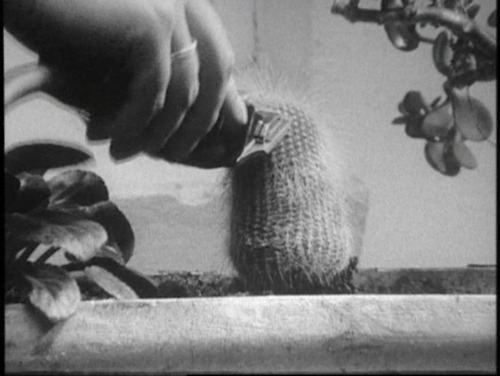
Ger van Elk, The Well-Shaven Cactus still, 1970.
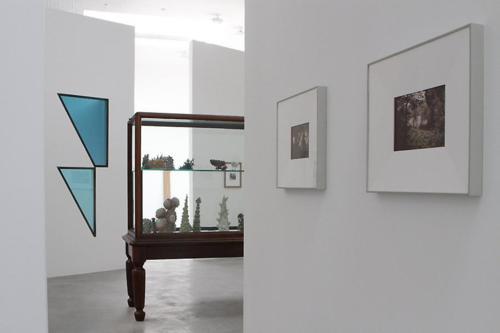
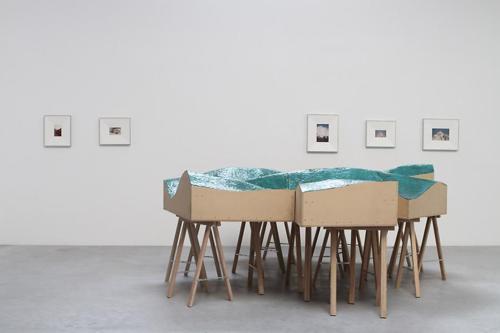
—
La Carte d’après Nature, an exhibition curated by Thomas Demand, will be on view at the Matthew Marks Gallery, 522 West 22nd Street (between 10th and 11th Avenues) through October 8, 2011. Gallery hours: Tuesday through Saturday, 11:00 A.M. to 6:00 P.M.
This exhibition is organized in conjunction with the Nouveau Musée National de Monaco, where it was originally presented last fall, and with the support of the René Magritte Foundation, Brussels. A catalogue with essays by Thomas Demand, Christy Lange, Tacita Dean, Rodney Graham, Luigi Ghirri and René Magritte accompanies the exhibition.
4 Oct 2011 / 4 notes / Happenings Elizabeth Bick Thomas Demand Luigi Ghirri August Kotzsch
Pingyao International Photography Festival
This week, Conveyor Editors Sylvia Hardy, Maria Sprowls and Alison Chen landed in Beijing. They caught a connecting flight to Taiyuan and drove to the ancient city of Pingyao for the Pingyao International Photography Festival.
Since arriving last week, we have made our way around the ancient city mostly by bicycle. On Tuesday, September 21, 2011 we celebrated the opening of the Pingyao festival. The week started rainy and gray, but, on the morning of the festival, blue skies broke open and filled with fireworks, confetti and hang gliders. The festival’s exhibiting photographers paraded down a red carpet towards the city gate as Mongolian music, drums rolls and voices in song illuminated their procession. Most of us had never experienced such an exuberant celebration in the name of photography. The festival exhibits over 20,000 photographic works in the same town. They bridge art with fashion, bring together emerging and well-known artists, and build a space where East meets West.
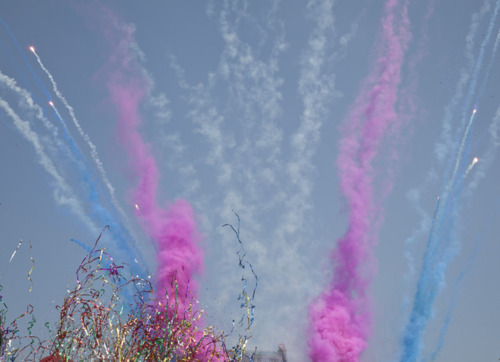
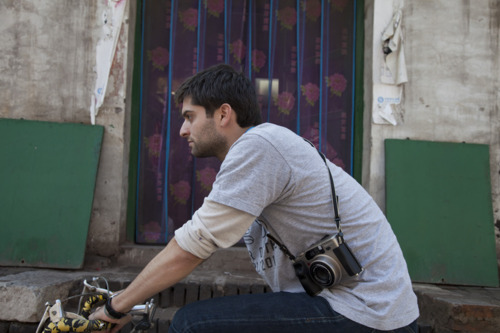
To further define the festival, we asked some of the artists participating in the exhibitions to share their thoughts on the city of Pingyao and it’s International Photography festival. Below are some of their images and thoughts:
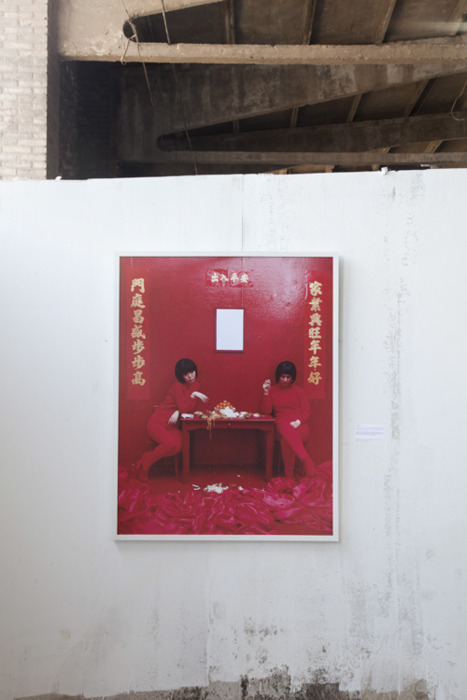
“The festival is a celebration of art. Our prints were crafted, printed and framed in a building on site, all funded by the Shanxi province.”
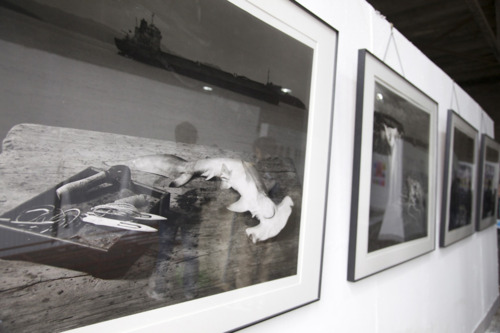
“It is an amazing production, as we witness frames being constructed and walls being built at amazing speeds — exhibitions are constructed out of air.”
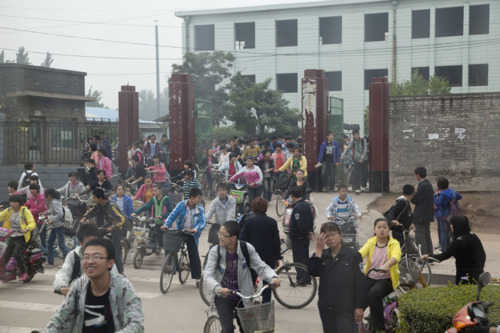
”A beautiful example of the human spirit.”
—-
Stay tuned for more from the Pingyao International Photography festival!
23 Sep 2011 / 1 note / Alison Chen Maria Sprowls PIP Pingyao Sylvia Hardy Happenings China
Pieter Hugo at Yossi Milo Gallery
Conveyor Editor-At-Large, Elizabeth Bick, explores Pieter Hugo’s seductive yet challenging work, Permanent Error, on display at Yossi Milo from September 8th through October 29th. Earlier this year, Prestel Press published a book of the work under the same title.
In his most recent project, Permanent Error, Pieter Hugo takes photographs of a technological wasteland that sits just outside of a small Ghanaian town called Agbogbloshie. The land is filled with digital debris of all kinds, including motherboards, cell phones, video games, and wiring. All of the technology is sent to Ghana broken or obsolete as a “donation” from companies and organizations in the United States and Europe.
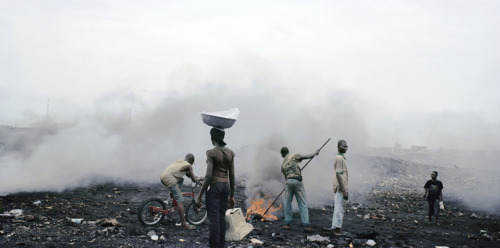
The depicted post-apocalyptic landscapes are inhabited by people who wander across the wasteland, sifting through mercury, PVC, and lead, looking for material to burn and sell as scrap. According to Frederica Angelucci, who wrote the essays for Hugo’s recent book on the project, “The area, on the outskirts of a slum known as Agbogbloshie, is referred to by local inhabitants as Sodom and Gomorrah, a vivid acknowledgment of the profound inhumanity of the place. When Hugo asked the inhabitants what they called the pit where the burning takes place, they repeatedly responded: ‘For this place, we have no name’.”
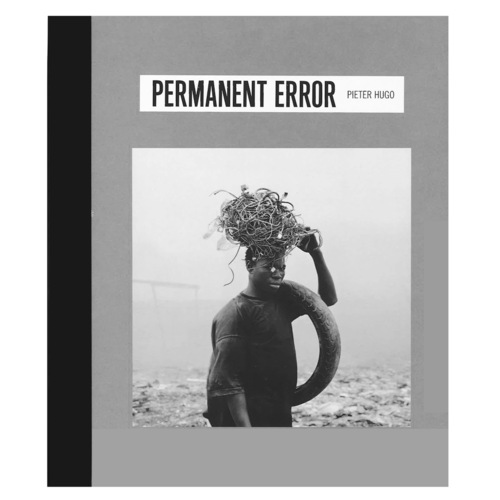
The exhibition of the work at Yossi Milo creates a visually charged window into another world. Typical of Hugo’s installations, life size or larger-scaled works sit in pristine white frames, dramatically contrasting the subject matter.
Standing before the series, it is difficult to fathom how exactly these images of inhumane living conditions fit into a gallery setting. The stunning photographs surface potentially unfamiliar environmental issues, yet, the works are being sold as commodities. We return to this question: is turning a painful situation into a set of aesthetically seductive photographs the most effective way to represent such a message to an audience? “There is no idyllic seasonal harvest in this vast dump of discarded technology,” Angelucci writes, “there is no chanting, no sign of festive gatherings at the end of a long day.” Likewise, perhaps there is no idyllic way to depict this wasteland.
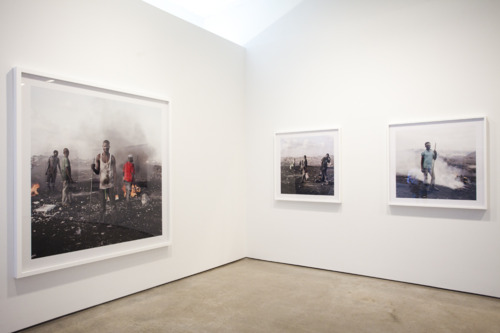

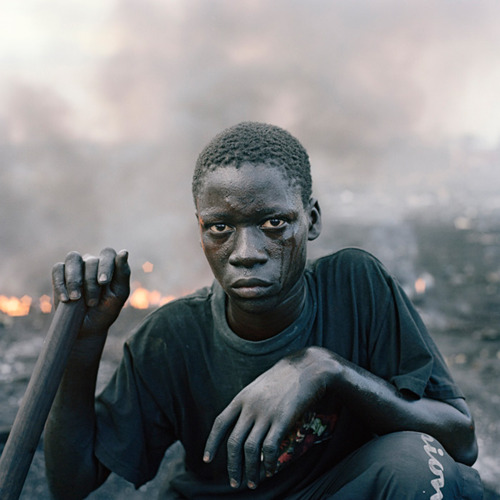
In the world of documentary photography and photojournalism, the jury is still out. Earlier this year, at the Photographic Universe Conference in New York City, photographer Andrea Geyer and professor Susie Linfield attempted to deconstruct the uncomfortable relationship between tragedy and representation. Click the links below to learn more about the conference and Geyer and Linfields discussion.
Click for Video Footage
http://photographicuniverse.parsons.edu/main
16 Sep 2011 / 4 notes / Happenings Elizabeth Bick Pieter Hugo Yossi Milo Andrea Geyer Photographic Universe Susie Linfield

